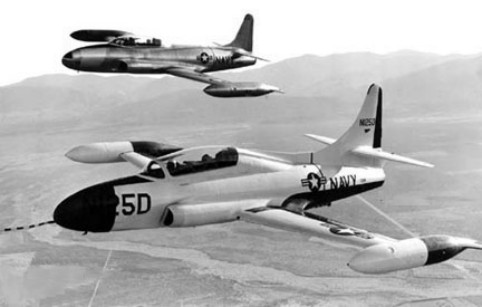Lockheed T2V on:
[Wikipedia]
[Google]
[Amazon]
 The Lockheed T2V SeaStar, later called the T-1 SeaStar, is a carrier-capable
The Lockheed T2V SeaStar, later called the T-1 SeaStar, is a carrier-capable
 ;
*
;
*

''Naval Aviation Chronology 1954–1959'' chapter from ''United States Naval Aviation 1910–1995'' book.
{{USAF trainer aircraft T02V 1950s United States military trainer aircraft Single-engined jet aircraft Low-wing aircraft Carrier-based aircraft Aircraft first flown in 1953
 The Lockheed T2V SeaStar, later called the T-1 SeaStar, is a carrier-capable
The Lockheed T2V SeaStar, later called the T-1 SeaStar, is a carrier-capable jet trainer
A jet trainer is a jet aircraft for use as a trainer, whether for basic or advanced flight training. Jet trainers are either custom designs or modifications of existing aircraft. With the introduction of military jet-powered aircraft towards the e ...
for the United States Navy
The United States Navy (USN) is the maritime service branch of the United States Armed Forces and one of the eight uniformed services of the United States. It is the largest and most powerful navy in the world, with the estimated tonnage ...
that entered service in May 1957. Developed from the Lockheed T-33
The Lockheed T-33 Shooting Star (or T-Bird) is an American subsonic jet trainer. It was produced by Lockheed and made its first flight in 1948. The T-33 was developed from the Lockheed P-80/F-80 starting as TP-80C/TF-80C in development, then d ...
(itself derived from the Lockheed P-80 Shooting Star
The Lockheed P-80 Shooting Star was the first jet fighter used operationally by the United States Army Air Forces (USAAF) during World War II. Designed and built by Lockheed in 1943 and delivered just 143 days from the start of design, prod ...
), it was powered by one Allison J33
The General Electric/Allison J33 is a development of the General Electric J31, enlarged to produce significantly greater thrust, starting at and ending at with an additional low-altitude boost to with water-alcohol injection.
Development
Th ...
engine.
Design and development
Starting in 1949, the U.S. Navy used the Lockheed T-33 for land-based jet aircraft training. The T-33 was a derivative of the Lockheed P-80/F-80 fighter and was first named TO-2, then TV-2 in Navy service. However, the TV-2 was not suitable for operation from aircraft carriers. The persisting need for a carrier-compatible trainer led to a further, more advanced design development of the P-80/T-33 family, which came into being with the Lockheed designation L-245 and USN designation T2V. Lockheed's demonstrator L-245 first flew on 16 December 1953 and production deliveries to the US Navy began in 1956. Compared to the T-33/TV-2, the T2V was almost totally re-engineered for carrier landings and at-sea operations with a redesigned tail, naval standard avionics, a strengthened undercarriage (with catapult fittings) and lower fuselage (with a retractable arrestor hook), power-operated leading-edge flaps (to increase lift at low speeds) to allow carrier launches and recoveries, and an elevated rear (instructor's) seat for improved instructor vision, among other changes. Unlike other P-80 derivatives, the T2V could withstand the shock of landing on a pitching carrier deck and had a much higher ability to withstand sea water-related aircraft wear from higher humidity and salt exposure.Operational history
The only version of the T2V was initially designated T2V-1 when it entered service, but was redesignated T-1A SeaStar under the 1962 United States Tri-Service aircraft designation system, the designation under which it would spend the majority of its career. The T-1A was replaced by the North American T-2 Buckeye but remained in service into the 1970s.Operators
 ;
*
;
* United States Navy
The United States Navy (USN) is the maritime service branch of the United States Armed Forces and one of the eight uniformed services of the United States. It is the largest and most powerful navy in the world, with the estimated tonnage ...
* United States Marine Corps
The United States Marine Corps (USMC), also referred to as the United States Marines, is the maritime land force service branch of the United States Armed Forces responsible for conducting expeditionary and amphibious operations through combi ...
Surviving aircraft
As of 2017, one T2V-1A airworthy, based at Phoenix-Mesa Gateway Airport (former Williams Air Force Base) in Mesa, Arizona, and being flown for experimental and display purposes. Two examples are preserved on public display inTucson
, "(at the) base of the black ill
, nicknames = "The Old Pueblo", "Optics Valley", "America's biggest small town"
, image_map =
, mapsize = 260px
, map_caption = Interactive map ...
, Arizona
Arizona ( ; nv, Hoozdo Hahoodzo ; ood, Alĭ ṣonak ) is a state in the Southwestern United States. It is the 6th largest and the 14th most populous of the 50 states. Its capital and largest city is Phoenix. Arizona is part of the Fou ...
.Ogden, p. 98
Specifications (T2V-1)

See also
References
;Notes ;Bibliography * Francillon, René J. ''Lockheed Aircraft since 1913''. London:Putnam, 1982. . * Ginter, Steve. ''Lockheed T2V-1/T-1A Seastar. Naval Fighters #42''. Simi Valley, California: Ginter Books, 1999. . * Ogden, Bob. Aviation Museums and Collections of North America. 2007. Air-Britain (Historians) Ltd. . * Swanborough, Gordon, with Bowers, Peter M. ''United States Navy Aircraft since 1911''. 1990. Putnam Aeronautical Books. . * Green, William, with Gerald Pollinger.'' The Aircraft of the World''. New York; Doubleday & Co., 1965. P. 255. * Green, William, with Dennis Punett. ''MacDonald World Air Power Guide''. London; Purnell & Sons, Ltd. (reprinted by Doubleday), 1963. P. 28.External links
''Naval Aviation Chronology 1954–1959'' chapter from ''United States Naval Aviation 1910–1995'' book.
{{USAF trainer aircraft T02V 1950s United States military trainer aircraft Single-engined jet aircraft Low-wing aircraft Carrier-based aircraft Aircraft first flown in 1953